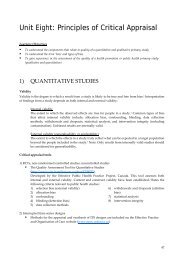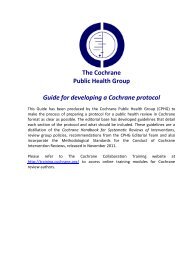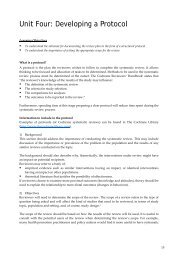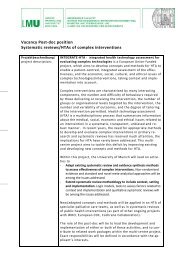Train the Trainer Course book - Cochrane Public Health Group
Train the Trainer Course book - Cochrane Public Health Group
Train the Trainer Course book - Cochrane Public Health Group
Create successful ePaper yourself
Turn your PDF publications into a flip-book with our unique Google optimized e-Paper software.
Reviewers should use <strong>the</strong> RE-AIM model 11 (Reach, Efficacy, Adoption, Implementation, and<br />
Maintenance) for conceptualising <strong>the</strong> potential for translation and <strong>the</strong> public health impact of an<br />
intervention. The user can <strong>the</strong>n compare <strong>the</strong>ir situation to <strong>the</strong> RE-AIM profile of <strong>the</strong> included studies<br />
or <strong>the</strong> body of evidence.<br />
RE-AIM:<br />
Reach – <strong>the</strong> absolute number, proportion, and representativeness of individuals (characteristics that<br />
reflect <strong>the</strong> target population’s characteristics) who are willing to participate in a given initiative,<br />
intervention, or program. Individual levels of impact.<br />
Efficacy/Effectiveness – <strong>the</strong> impact of <strong>the</strong> intervention on important outcomes, including potential<br />
negative effects, quality of life, and economic outcomes. Individual levels of impact.<br />
Adoption - <strong>the</strong> absolute number, proportion, and representativeness of settings and intervention<br />
agents (people who deliver <strong>the</strong> program) who are willing to initiate a program. Comparisons should<br />
be made on basic information such as resource availability, setting size and location, and<br />
interventionist expertise. Organisational levels of impact.<br />
Implementation – at <strong>the</strong> setting level, implementation refers to <strong>the</strong> intervention agents’ integrity to<br />
<strong>the</strong> various elements of an intervention’s protocol, including consistency of delivery as intended and<br />
<strong>the</strong> time and cost of <strong>the</strong> intervention. At <strong>the</strong> individual level, implementation refers to clients’ use of<br />
<strong>the</strong> intervention strategies. Organisational levels of impact.<br />
Maintenance – The extent to which a program or policy becomes institutionalised or part of <strong>the</strong><br />
routine organisational practices and policies. At <strong>the</strong> individual level, it refers to <strong>the</strong> long-term effects<br />
of a program on outcomes after 6 or more months after <strong>the</strong> most recent intervention contact. Both<br />
individual and organisational levels of impact.<br />
Example – taken from www.re-aim.org<br />
A school-based intervention that has a large impact in terms of reach and efficacy at <strong>the</strong> individuallevel<br />
but is only adopted, implemented and maintained at a small number of organisations (with<br />
specific resources that are not available in typical ‘real-world’ schools) could potentially be described<br />
as an intervention that has a large potential for impact (if <strong>the</strong> RE-AIM model was not used). In reality,<br />
when considering organisational-level impact, in addition to individual –level impact, this<br />
intervention would have little hope of resulting in a large public health impact because it could not<br />
be adopted, implemented and maintained in real-world settings.<br />
This is also true of <strong>the</strong> converse situation where an intervention has systemic organisational adoption,<br />
implementation, and maintenance, but little reach, efficacy or maintenance at <strong>the</strong> individual level. So<br />
if only one level was assessed (i.e. <strong>the</strong> organisational level) <strong>the</strong> impact of <strong>the</strong> intervention would be<br />
considered large even though <strong>the</strong>re is no individual-level reach, efficacy or maintenance.<br />
Case study - The Victoria Council on Fitness and General <strong>Health</strong> Inc. (VICFIT)<br />
VICFIT was established through <strong>the</strong> Ministers for Sport and Recreation and <strong>Health</strong> to provide advice<br />
to government and to coordinate <strong>the</strong> promotion of fitness in Victoria. One of VICFIT's initiatives, <strong>the</strong><br />
Active Script Program (ASP), was designed to enable all general practitioners in Victoria to give<br />
consistent, effective and appropriate physical activity advice in <strong>the</strong>ir particular communities. The<br />
evaluation of <strong>the</strong> initiative utilised <strong>the</strong> RE-AIM framework, which is available at<br />
http://www.vicfit.com.au/activescript/DocLib/Pub/DocLibAll.asp.<br />
124








